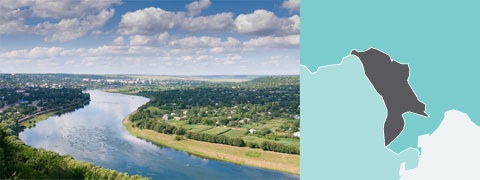Country assessments
Moldova
- Details
- Country assessments
2013 sector transition indicators
Source: EBRD.
Note: Water – Water and wastewater; IAOFS – Insurance and other financial services; PE – Private equity.
Highlights
- The economy has recovered from last year’s recession. Industrial output increased in response to more favourable external demand, agricultural output recovered from the drought, and remittances have continued to grow, although they still remain below their peak prior to the 2008-09 global financial crisis.
- Long-standing governance problems in the banking sector flared up. Ownership changes in one of the largest banks led to a dispute among shareholders, and another systemic bank was de facto privatised through its recapitalisation. These events highlighted the limited capacity of the central bank – the National Bank of Moldova – to effectively enforce fit and proper policies, as well as the weakness in the country’s judicial system to secure property rights.
- The authorities continued to make progress towards approximation with the European Union (EU). Negotiations were concluded on an Association Agreement and the creation of a Deep and Comprehensive Free Trade Area (DCFTA) with the EU. Economic ties with Romania were strengthened, with the initiation of several energy projects.
Key priorities for 2014
- It is critical to ensure that policies on governance and transparency of banks are implemented. Effective enforcement of the central bank rules on disclosure of beneficial owners and fit and proper policies are needed for financial sector stability and overall improvement in the quality of governance in the economy. Fundamental changes in the judicial system are also needed in order to ensure good rules on the books are effectively enforced.
- The authorities should pursue policies to attract and stimulate investment. Privatisation of the landline telecommunication monopoly, the national airline and parts of the rail network should help attract private sector investment in these critical areas.
- Reforms to increase energy security and energy efficiency should continue. Implementation of the Energy Community Treaty, completion of the integration of the country’s energy networks with those of Romania, and enforcement of policies targeting greater cost recovery in the energy sector should help to diversify energy sources and increase investment in the sector over time.
Macroeconomic performance
Economic recovery resumed after last year’s contraction. In 2012 GDP declined by 0.8 per cent in response to weakening external demand in the EU and unfavourable weather conditions. In the first half of 2013 real output increased by 4.9 per cent year-on-year, supported by growing remittances, and a recovery in industrial exports and agricultural production. Inflation has remained below its recent peak of 9 per cent in 2011, and within the central bank’s target range of 3.5-6.5 per cent. This has allowed the central bank to reduce the policy rate by 650 basis points since October 2011, to 3.5 per cent in September 2013. As the current account deficit narrowed, the central bank was able to accumulate reserves, estimated at around five months of imports in August 2013. The budget deficit has remained contained, at around 1.5 per cent of GDP in the first half of 2013, and general government debt has remained low, with few immediate rollover risks.
The relatively strong external position allowed the authorities to maintain stability while official inflows declined. The International Monetary Fund-supported programme, which was initiated in 2010, expired in April 2013 without final review. While the arrangement achieved its main objective of stabilising the economy after the 2008-09 crisis, several policy measures adopted during the period of political instability in the spring of 2013 are likely to turn the fiscal policy pro-cyclical; in particular, the proposed introduction of a flat tax in the agricultural sector. The banking sector remains generally stable, with the non-performing loans ratio declining to 13 per cent of gross loans in June 2013, from 15 per cent a year earlier. However, governance and transparency issues in banks subject the sector to potential instability. High dollarisation of the financial system continues to expose the sector to risks related to devaluation or capital flow reversal. In this regard, the central bank has made progress towards the implementation of inflation targeting, and has pursued policies to encourage local currency lending.
The country’s longer-term prospects hinge on the ability to create conditions for investment-led growth. In the short term, the Moldovan economy will continue to depend on the EU and Russia for remittances and export demand. To increase incomes from the current low level, private sector investment will need to increase substantially, along with the already expanding access to various markets. The government will need to persevere with the implementation of institutional reform, in particular to ensure an independent and impartial judiciary, reduce corruption, and further improve tax and customs administration.
Major structural reform developments
The pace of improvement in Moldova’s business environment has picked up over the past year. The introduction of electronic filing and payment systems for various corporate taxes was largely responsible for Moldova being upgraded to seventy-eighth of 189 countries in the World Bank 2014 Doing Business report, rising only marginally in the global ranking in the period 2012-14, after its remarkable improvement from 2011-12. It is likely that the mixed progress in reforms over the past two years reflected the intensifying political crisis that culminated in the dissolution of the government in March 2013. The new government, which was formed in May 2013, is committed to accelerating the pace of reforms, and has established committees charged with exploring reforms to further cut red tape, decrease the regulatory burden, reduce corruption and stimulate competition.
Governance in the financial sector suffered from a number of challenges. Faced with strong political resistance, the authorities have been unable to enforce the strengthened regulations on bank governance. At the start of 2013 ownership of a significant cumulative stake in Moldova Agroindbank – the country’s largest bank – took place without prior written consent of the National Bank of Moldova as required by the 2012 Law on Financial Institutions and Securities Market. Another non-transparent transaction took place in September 2013, when the state allowed control of country’s fourth-largest bank – Banca de Economii (BEM) – to be transferred to a little-known private company in a recapitalisation process. The central bank has been working to establish a more comprehensive supervision system that would allow it to move towards risk-based banking supervision. In July 2013 the parliament passed the Law on Consumer Loans, which envisages better protection for consumers and an extension of consumer rights, promotes banking product transparency, and aims to reduce misbehaviour and fraud by financial institutions. At the same time, the enforcement of creditor rights continues to suffer from an ineffectual and corrupt judicial process.
The privatisation process slowed, partly reflecting the unfavourable global environment. In 2012 the government embarked on the privatisation of 41 medium-sized companies. However, the process virtually stopped in the first half of 2013. In July 2013 the parliament further reduced the list of state enterprises that are excluded from possible privatisation (from 175 to 120), which included permitting the privatisation of several energy sector enterprises and water companies, as well as Chisinau airport. The formerly state-owned BEM had to be recapitalised, but longer term challenges related to its balance sheet and governance need to be addressed before it will be able to attract a reputable strategic investor.
Moldova has made important steps towards further approximation with the EU. In June 2013 Moldova concluded the technical part of negotiations with the EU on the Association Agreement, including the creation of a DCFTA, which, once effective, is expected to bolster trade between Moldova and the EU, improve the business environment and attract new foreign investments to the economy. In July 2013 the governments of Moldova and Romania agreed on a start date for the long-awaited construction of the Iasi-Ungheni gas pipeline, which will connect the two countries’ gas transportation systems and promote energy diversification for Moldova, which is at present fully dependent on Russian supplies. In August 2013 the Austrian-Romanian consortium, which was selected in a tender, started construction works, with completion expected by April 2014. Moreover, integration of both countries’ electricity grids is ongoing. Significant efforts to improve road, port and railway infrastructure, supported by international financial institutions, should reduce the cost of international trade and help Moldova capitalise on its transit potential. In July 2013 the parliament approved the Law on Internal Water Transport, which regulates the domestic maritime industry.
The government is pursuing policies to increase the financial independence of local authorities. In July 2013 the parliament passed changes in the law on local public finances to increase the financial autonomy of local authorities. According to the law, 75 per cent of personal income tax proceeds will stay in local budgets, while the allocation of transfers will be based on income in order to balance the administrative and territorial budget, rather than on a per capita basis as previously. The allocation system will use a formula to distribute funds, which should minimise human and political factors in decision-making, and promote fairness and transparency. As a result, local authorities will have more spending and decision-making authority.













